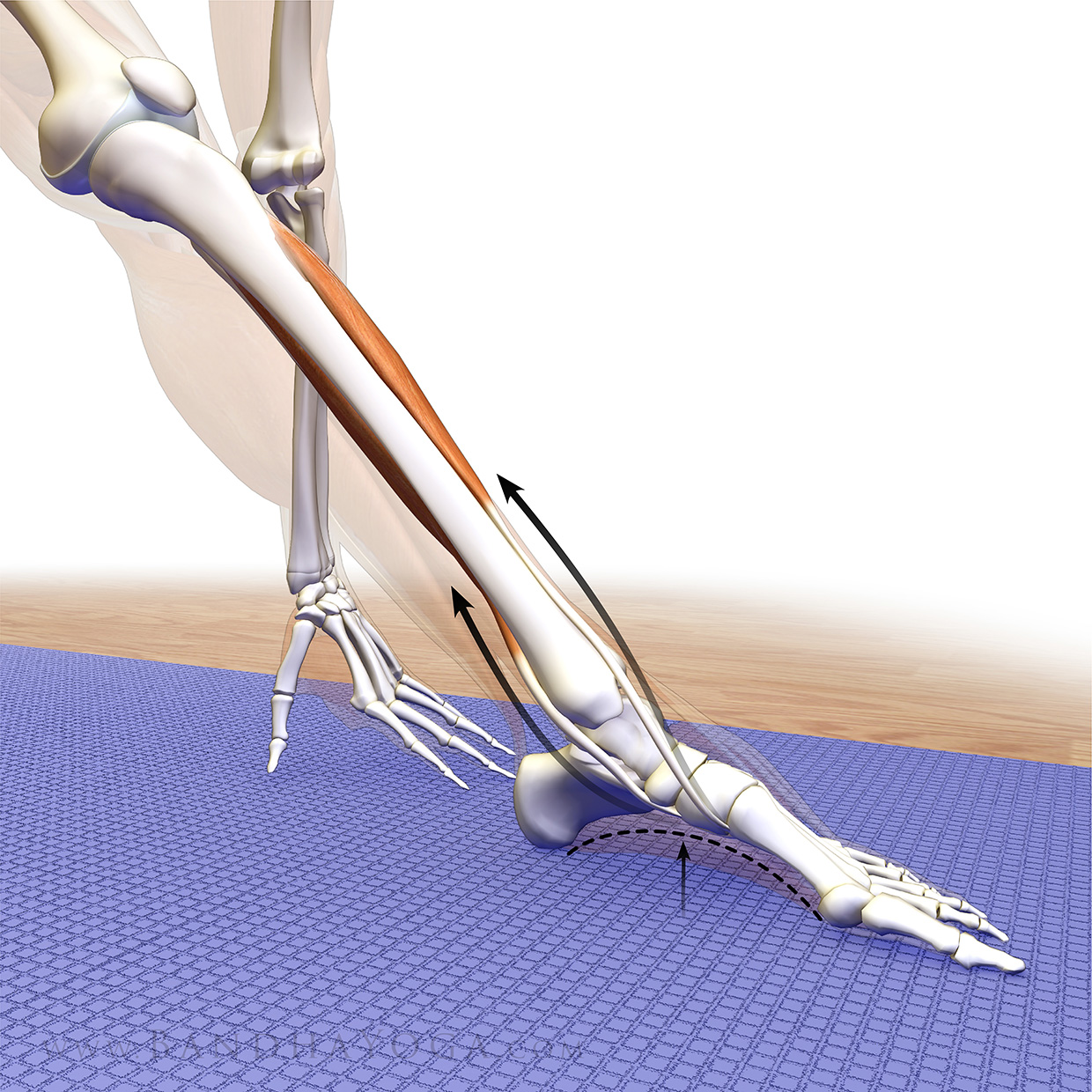Hello Friends,
William Blake said you can see the world in a grain of sand. Similarly, fundamental principles you master in one asana are portable to others. With this in mind, let’s look at the key elements for activating your foot arch in the front leg foot in Trikonasana (Triangle Pose). Here’s the cue…
First, press the outer edge of your foot into the mat. This engages the tibialis anterior and posterior muscles of the lower leg (figure 1).
Maintain that action as you press the ball of your foot into the mat. This engages the peroneus longus and brevis muscles on the outside of your lower leg (figure 2).
Co-activating the muscles that invert (supinate) and evert (pronate) your foot creates an opposing force between these two antagonistic actions that stabilizes your ankle.
These same muscles work together (as synergists) to lift your foot arch (figures 3 and 4).
Click here to learn about another antagonist/synergist combination. Click here to learn more about your foot arch…
Review the last two posts to see how to connect the foot arch to your core.
I hope you enjoyed this blog post. Page through the Key Muscles and Key Poses of Yoga and the Yoga Mat Companion Series to learn more about anatomy and biomechanics for yoga. See you next week when I will post another tip on anatomy and biomechanics for yoga.
Best,
Ray Long, MD
William Blake said you can see the world in a grain of sand. Similarly, fundamental principles you master in one asana are portable to others. With this in mind, let’s look at the key elements for activating your foot arch in the front leg foot in Trikonasana (Triangle Pose). Here’s the cue…
First, press the outer edge of your foot into the mat. This engages the tibialis anterior and posterior muscles of the lower leg (figure 1).
 |
| Figure 1 |
Maintain that action as you press the ball of your foot into the mat. This engages the peroneus longus and brevis muscles on the outside of your lower leg (figure 2).
 |
| Figure 2 |
Co-activating the muscles that invert (supinate) and evert (pronate) your foot creates an opposing force between these two antagonistic actions that stabilizes your ankle.
These same muscles work together (as synergists) to lift your foot arch (figures 3 and 4).
 |
| Figure 3 |
 |
| Figure 4 |
Click here to learn about another antagonist/synergist combination. Click here to learn more about your foot arch…
Review the last two posts to see how to connect the foot arch to your core.
 |
| An excerpt from "Yoga Mat Companion 1 - Anatomy for Vinyasa Flow and Standing Poses". |
 |
| An excerpt from "Yoga Mat Companion 1 - Anatomy for Vinyasa Flow and Standing Poses". |
I hope you enjoyed this blog post. Page through the Key Muscles and Key Poses of Yoga and the Yoga Mat Companion Series to learn more about anatomy and biomechanics for yoga. See you next week when I will post another tip on anatomy and biomechanics for yoga.
Best,
Ray Long, MD

Thank you for all the educational tips .
ReplyDeleteCan you please help with ways to avoid hypertension of the knees ?
Namaste orly
Hi, for hyperextension in the knees keep a micro bend in the front leg, engage the knee cap, pulling it up and activating the quadriceps. It´s a bit of getting used to. The cues in the article are super useful. You can also use a block placed diagonally behind the calf of the front leg until the student understands where to activate in the foot and leg. Good luck!
DeleteHello Orly,
DeletePlease see this blog post for hyperextension of the knees:
https://www.dailybandha.com/2011/03/tip-for-helping-hyperextended-elbows.html
Ray
Hi Ray!
ReplyDeleteAlways enjoy receiving and reading your cue's. Hope life has been great and i am sure you are super busy. Love your perspective on also lifting the toes (not the balls of the feet) to also help active the arch? I've found mixed level students can access that action pretty easily and i am thinking that is a third action to do along with your two you mention. Thoughts? All the best..Peter
Hi Peter, good to hear from you. Hope all is well. Yes, that works for aiding the lift of the arch. Here's a blog post that helps with it.
Deletehttps://www.dailybandha.com/2013/09/plantar-fasciitis-myofascial.html
Best~Ray
Hi Dr. Long,
ReplyDeleteThank you for the numerous illustrations and explanations.
Is it safe to develop straight arm strength as seen in the planche or in gymnastics?